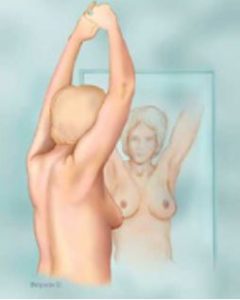ULTRASOUND VS MAMMOGRAM
The examination of a young woman with a breast lump that can be felt is somewhat contradictory. The mammae (breasts) are more sensitive to radiation and usually very dense due to pronounced glandular tissue, making mammograms more difficult. In addition, breast cancer is less common at a young age.
Ultrasound is therefore considered to be the optimal choice for young women. This method is non-invasive and does not involve radiation. It is, however, important to add that its reliability is largely dependent upon the individual administering the ultrasound. Experience plays a vital role.

Previously, ultrasound was primarily seen as a method to distinguish tumors from cysts or to monitor an abscess. However, the quality of ultrasound equipment has improved substantially in recent years.
The most recent generation of ultrasound devices are systems with high resolutions and thus able to do far more than to differentiate between cyst or a solid lesion. With the high resolution offered by today’s ultrasound technology, tumors smaller in size than 1 centimeter can be spotted. Early recognition of small tumors is essential as it enables treatment to take place when metastases have not yet occurred. In addition, ultrasound can visualize a palpable abnormality in a mammographically dense breast.
Mammography is very useful for older women with fatty glandular tissue, but often leaves much to be desired in young women with dense mammary tissue and women who suffer from painful lumpy breasts (mastopathy). A medical indication for mammography in young women is rare. In general, ultrasound examinations take precedence over x-ray examinations in these patient groups.
Another advantage of using ultrasound as opposed to mammography is its ability to determine the exact measurement of the tumor size. Combined with the ability of ultrasound technology to spot microcalcifications makes it possible to arrive at suitable therapies. As a woman grows older, there’s a greater likelihood of a palpable lump in the breast being malignant and the reliability of mammography increases.
In the Netherlands, women between the ages of 50 and 75 are invited to participate in the breast cancer screening program every two years. At these screenings, they undergo a mammogram. There is no question that this screening program is vital in detecting breast cancer in this age group. However, even in older women, an ultrasound control is recommended in addition to the biannual mammography.
Table 1. Comparison between ultrasound and mammograms
|
